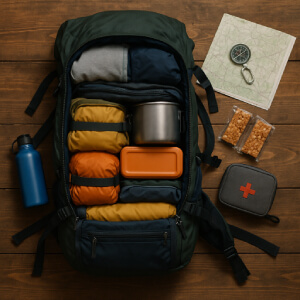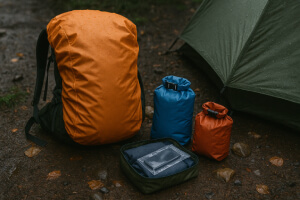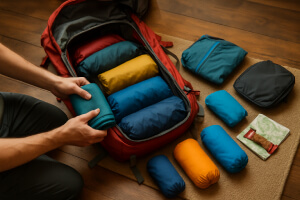If a backpack is not packed well, your hike becomes a struggle. A proper pack can equalize weight, give you accessibility to must-have items, comfort you during long-distance treks, or even help you stay on track while hiking. Whether it is a day hike or a multi-day trek, having an idea about the packing principles will help you better organize, keep safe, and have efficiency. This will guide you step by step with the main principles, placement, gear, and tips.
Essential Packing Principles
Before filling a backpack, it is important to take note of certain fundamental concepts related to efficient and comfortable packing. Things like even distribution of weight, easy accessibility, and protection of gear prevent unnecessary strain and ensure a safe hike.

Prioritize Weight and Balance
The number one rule in backpack packing is weight management. Failure to distribute weight properly puts pressure on the shoulders, back, and hips, causing discomfort and sometimes injury. Heavy objects such as food, water, and cooking gear should be kept near the spine, near mid-back. This position stabilizes the center of gravity and decreases the effort required to maintain balance on uneven terrain.
Accessibility and Organization
Packing a backpack does not only consist of carrying weight; it also entails knowing where everything is. Things you may need right away should always remain within reach of your hands without requiring that you actually take off your pack: maps, snacks, rain jackets, and first aid kits.
Use smaller internal pouches or compression sacks to keep similar items together. This reduces clutter, keeps gear from shifting around while hiking, and allows you to get to an item quickly without having to unpack your entire bag.
Packing Different Sections of Your Backpack
A hiking pack commonly has four main zones: bottom, middle, top, and outside pockets. Knowing what to put in each section improves balance, accessibility, and convenience.
Bottom Section
This is for lightweight yet bulky items that are not needed right away, such as sleeping bags, pads, or extra clothes. Sleeping bags, especially, would benefit from the use of a compression sack to shrink its packing size while also protecting it from moisture.
If carrying a multi-day pack, do not pack anything heavy here as it could destabilize the pack and exert pressure on the lower back. Use this area to carry insulating layers or items mostly used at camp.
Middle Section
The heavier items must be in the center area of the pack. These include food, water (or hydration reservoirs), cooking gear, and sometimes parts of the tent. Load these items closest to your back so that the weight is fixed down low and centered for easier balance when negotiating difficult terrain.
If there is something used frequently, keep it slightly forward or in a side compartment so you don’t have to dig around inside the pack while walking. Zipped pouches or dry bags are great to have around so that spills or moisture won’t be an issue.
Top Section
Think of the upper section as the working part. That is where all things need to be easily accessible: some snacks, a jacket, a hat, gloves, a pair of down-the-glass sunglasses, or a first-aid kit. Some packs accord special treatment to this sort of items in the form of a “brain” compartment.
Heavy gear, however, belongs nowhere near the top, since it only serves to make the pack feel top-heavy and sit back on you. Keep weight up but keep it light for comfort.
Exterior Pockets and Straps
For big items that don’t fit into the regular compartments or need to be accessed quickly, use exterior pockets and straps. These might include water bottles, trekking poles, rain gear, maps, and sometimes a small daypack.
Never overpack the extrernal parts as they throw off your balance or can easily catch on a branch. Put in the side pockets, water, and the small gear while the straps will hold the big things, such as a sleeping pad and tent.
Protecting Gear From the Elements

Weather changes quite fast outdoors, so in any case, protecting your gear should be considered. Waterproof sacks, dry bags, pack covers are some methods to keep essentials from being soaked to the bone. Electronics, clothes, and food must go into waterproof containers to avert their being ruined.
Furthermore, it is recommended to layer a fragile item with soft clothing or padding to stop any damage from shifting around-heavy or hard objects should not be put on the top of cameras and phones-or on anything delicate for that matter.
Tips for Efficient Packing

Packing a backpack is part science and part art. With a few easy tricks, you can carry a lighter load that’s organized and comfortable.
- Roll Clothes: Rolling clothes even saves space and wrinkles. It also makes it a bit easier to put the clothes in sacks for compression.
- Use Compression Sacks: Compression sacks reduce volume while keeping items of similar types together, usually with bulky clothes or sleep bags.
- Test Your Pack: Try packing your gear and walking around the house before hitting the trail. Adjust the weight so it’s comfortable and balanced.
- Pack Last for Quick Access: Rain gear, snacks, and maps should be packed last for quick access without having to operate unpack your entire bag.
- Go Modular: Some packs allow modular packing with removable compartments or detachable daypacks to allow flexibility for shorter excursions.
Quick Access and Safety Essentials
The best thing to do is to keep items of convenience and safety handy while going on a trail. Place short-term items such as maps, snacks, first-aid kits, and rain gear in the top compartment or side pocket for quick access without having to take off the backpack. Make sure to protect organic, fragile, or crucial items to prevent any damage and to have an organized way of getting to them quickly. Time-saving will give you time to address a sudden turn in the weather, a minor injury, or a simple need for help with navigation. Together, it ensures that you stay safe and prepared.
Gear Up Without the Strain
Packing for hiking equilibrates careful attention to weight distribution, organization, and protection of equipment. Put heavy items near the back; light things go on top or in external pockets for easy access, while sensitive items are shielded from weather or impact. Compression sacks are the best guarantee for comfort, rolling clothes down, and testing the pack on beforehand for efficiency and safety. Mastering these skills will enable you to concentrate on enjoying the trail instead of the discomfort or your disorganization.
